Host the Best Easter Egg Hunt for Dogs in 2025
Easter isn’t just for kids—it’s a wonderful time for our dogs to join the excitement too. Hosting an Easter egg hunt for dogs is a creative way to keep your pup entertained while strengthening the bond you share.
This activity combines fun, treats, and a touch of holiday magic, making it unforgettable for both dogs and their humans.
You can even add a bit more charm to your celebration by downloading Easter dog coloring pages from Etsy, perfect for families looking to include kids in the festivities too.
Planning the Perfect Easter Egg Hunt for Dogs
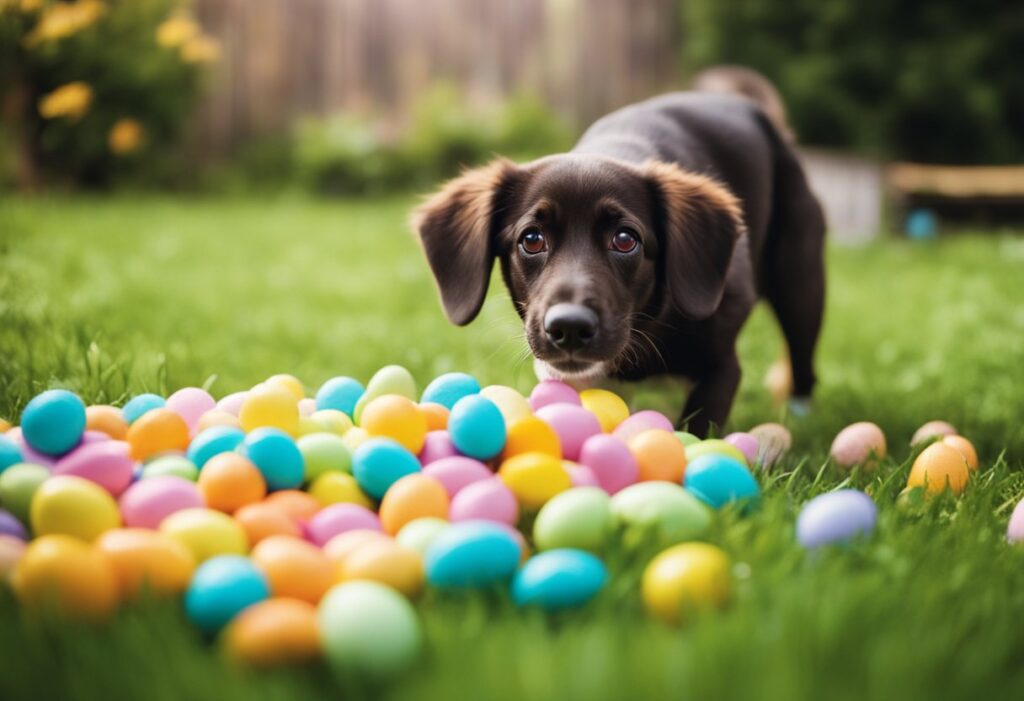
Creating an Easter egg hunt for dogs requires careful planning to keep things entertaining, safe, and hassle-free. From picking the right location to choosing tasty treats and sourcing appropriate materials, every detail matters to ensure your furry friends have a memorable experience. Let’s break it down.
Selecting the Venue
Choosing the perfect location is a top priority for a dog-safe egg hunt. A fenced yard works great for keeping dogs secure while they search for goodies, but if you’re inviting multiple pups or need more space, opt for a pet-friendly park. Look for areas free of potential hazards like toxic plants or sharp debris.
Double-check local park rules to confirm pets are welcome and that off-leash play is permitted if needed. Take a look at our local dog parks in the Orlando area.
A dog-friendly environment not only ensures safety but also creates an inviting atmosphere for your playful fur guests. Whether it’s your backyard or a well-chosen community spot, the venue sets the stage for a tail-wagging adventure.
Choosing Dog-Safe Treats
What’s an Easter egg hunt without tasty surprises? Since this activity revolves around treats, it’s essential to select goodies that are both delicious and safe for dogs. Some excellent choices include:
- Peanut butter treats (ensure they’re xylitol-free)
- Dehydrated meat snacks
- Soft training treats
- Homemade options like pumpkin biscuits or gingersnaps
If you’re not sure where to start with making treats, check out 3 Treat Recipes Your Dog Will Love. It’s also important to factor in dietary restrictions or food allergies dogs may have. Communicate with other pet parents if you’re hosting group events to avoid potential health issues.
Gathering Materials for the Hunt
Choosing the right “eggs” and fillers is another critical step. Since real plastic Easter eggs can pose a choking risk or may splinter, opt for non-toxic and pet-safe containers that can hide treats but withstand curious noses and paws. Great options include:
- Durable puzzle toys with hidden compartments
- Reusable silicone molds or food-safe containers
- Stuffable toys like Kongs, which create an extra challenge for treat retrieval
If your dog is a gentle chewer, you could even use colorful cloth pouches or fabric-wrapped treats to give the hunt a festive touch. Brightly colored items help dogs locate their prizes more easily during the search.
Remember to always supervise to ensure no materials get chewed apart unnoticed!
By using safe materials and treats, you’ll not only keep your dog entertained but also ensure their safety while celebrating.
Training and Preparing Your Dog
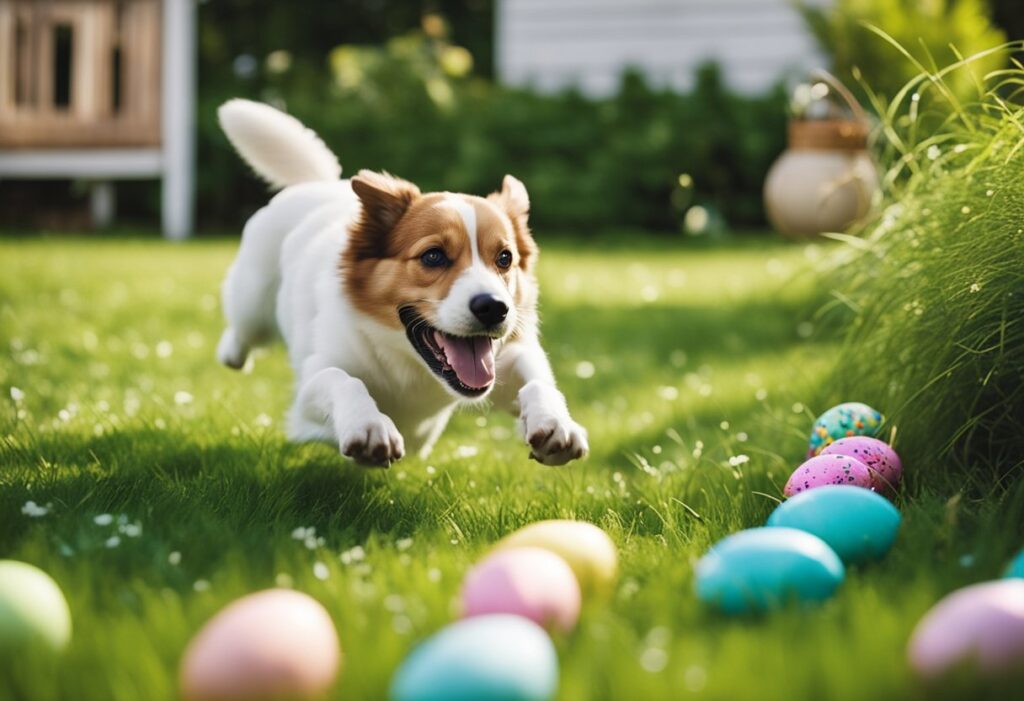
Preparing your dog for an Easter egg hunt is not only about fun—it’s also an opportunity to practice obedience, reinforce training, and build confidence. To keep the event enjoyable and stress-free, you’ll want to focus on teaching your dog the skills they need to participate safely and successfully. Here’s how to get started.
Introducing the Concept to Your Dog
Dogs are natural scent detectives, making them perfect candidates for an Easter egg hunt adventure. To teach your pup to search for treats using their nose, start small with simple steps:
- Use high-value treats: Select treats with a strong smell to trigger their natural sniffing instincts.
- Start with easy hiding spots: At first, place the treat in plain sight, encouraging your dog to sniff it out. Gradually make it harder as they grasp the concept.
- Pair a command with the activity: Use a word like “find it” to associate sniffing with a reward. Be consistent with this phrase so they connect the dots.
Take your time during these steps and reward every success. Over time, your dog will not only look forward to the activity but will master finding hidden treats like a pro. For additional tips on training techniques, check out 10 Best Dog Training Tips.
Basic Commands for a Safe Hunt
Hosting an Easter egg hunt for dogs comes with a need for control and safety. Teaching basic commands ensures your event runs smoothly. Key commands to focus on include:
- “Leave it”: This command can prevent your dog from chewing on plastic containers or unsafe items.
- “Find it”: Use this as a command to signal their start to the hunt, keeping them engaged.
- “Come”: Always critical in any outdoor activity for redirecting or calling your dog back.
If these commands aren’t already part of your dog’s repertoire, don’t worry. With short, focused training sessions, most dogs can pick them up quickly. For step-by-step guidance, refer to Basic Commands to Teach Your Dog. These basic commands create a foundation of safety and fun for your Easter event.
Socializing with Other Dogs
If your hunt includes multiple participants, socializing your dog beforehand is a must. Dogs thrive on structured interaction, but unmanaged group settings can sometimes lead to stress or conflict. Follow these guidelines for a safe, harmonious environment:
- Introduce dogs gradually: Allow brief, supervised introductions before the event starts. Ensure all dogs are comfortable with each other.
- Monitor body language: Look for signs of stress or dominance, such as growling, stiff posture, or excessive barking.
- Have designated handlers: Assign each dog to a person who can guide and redirect them during the hunt if necessary.
Clear rules and watchful supervision create a fun atmosphere for everyone. To explore more on this topic, read The Benefits and Importance of Socializing Your Dog. Socializing not only enhances your dog’s behavior—it also makes group activities like an Easter egg hunt more enjoyable.
By following these steps, you’ll prepare your dog for an engaging and safe hunt that’s sure to delight pups and their humans alike!
Creating a Fun and Memorable Experience
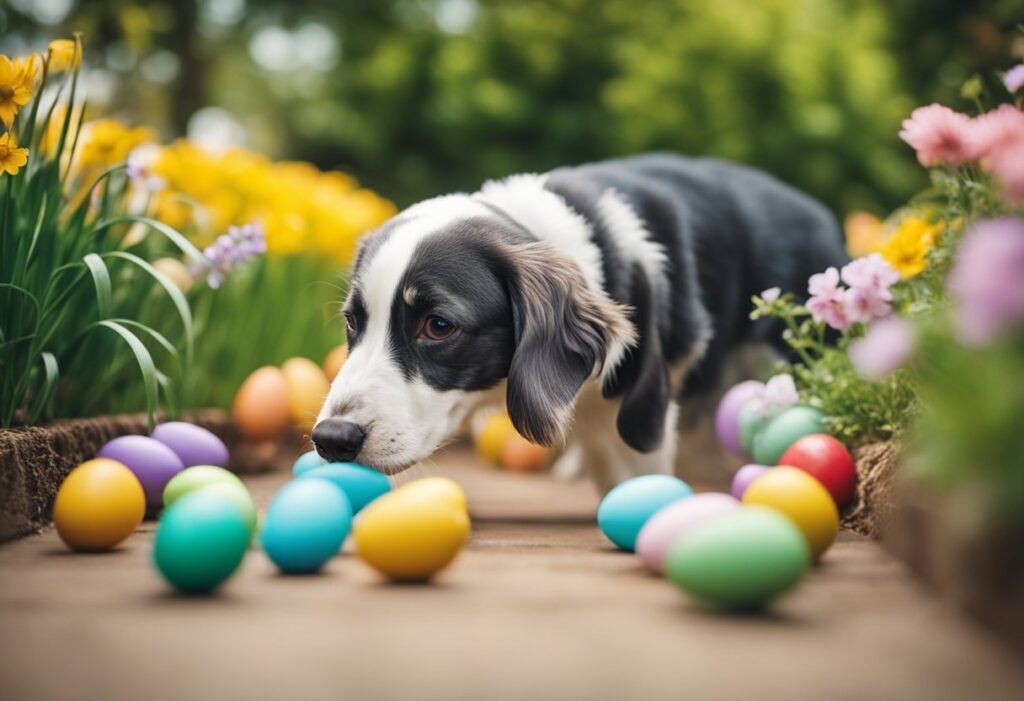
An Easter egg hunt for dogs isn’t just about the thrill of finding treats—it’s about building an event that’s enjoyable for both pets and their humans. By incorporating festive decorations, engaging activities, and lasting memories, you can craft a one-of-a-kind celebration that everyone will adore.
Decorations and Easter Themes
The right decorations can transform a simple gathering into an Easter wonderland. Go for bright, pastel colors that are synonymous with Easter, and make sure to include a mix of textures, balloons, and colorful backdrops. Here are some ideas to make the environment pop:
- Dog-friendly flower arrangements: Use edible flowers like pansies or snapdragons to make it festive and safe if curious pups get too close.
- Customized Easter baskets: Tailored to different breeds or sizes, these can double as decor and giveaways.
- Outdoor candy-free egg displays: Use oversized plastic eggs or even painted rocks to create a festive hunt area.
- Photo props: Incorporate bunny ears for dogs, Easter hats for humans, and signs like “Eggcellent Finder!” for photo ops.
Hosting Games Beyond the Egg Hunt
While the Easter egg hunt will undoubtedly be the highlight, adding more games ensures all attendees—dogs and humans—stay engaged. Some paw-some dog-friendly activities to consider include:
- Agility courses: Set up simple hurdles, tunnels, or weave poles to challenge a pup’s agility.
- Sniff-and-search challenge: Lay out multiple scent boxes where dogs can practice their sniffing skills to identify the one containing the treat.
- Obedience contests: Small competitions like “fastest sit” or “best trick” add variety and encourage active participation from owners.
Keep every activity safe and adaptable to the energy levels of various dogs.
Capturing the Moment
No event is complete without some memorable snapshots. Encourage owners to document their dog’s excitement and silliness during the hunt. Here are some pro tips for capturing share-worthy content:
- Get at their level: Kneel or lie down to get action shots at a dog’s eye view.
- Focus on expressions: Dogs with their noses in an egg or proudly showing off their finds make for heart-melting moments.
- Use natural light: Hosting the event in the daytime ensures bright, colorful photos.
Make it easy for guests to share their memories on social media by setting up a photo station. Include a hashtag (like #DogEasterFun) and props to encourage creative posts. After all, what better way to celebrate your Easter-themed dog party than by going viral with its adorable moments?
For more information about how to get good photos of your dog, take a look at how to do an Easter photoshoot with your dog.
Ensuring Safety During the Egg Hunt
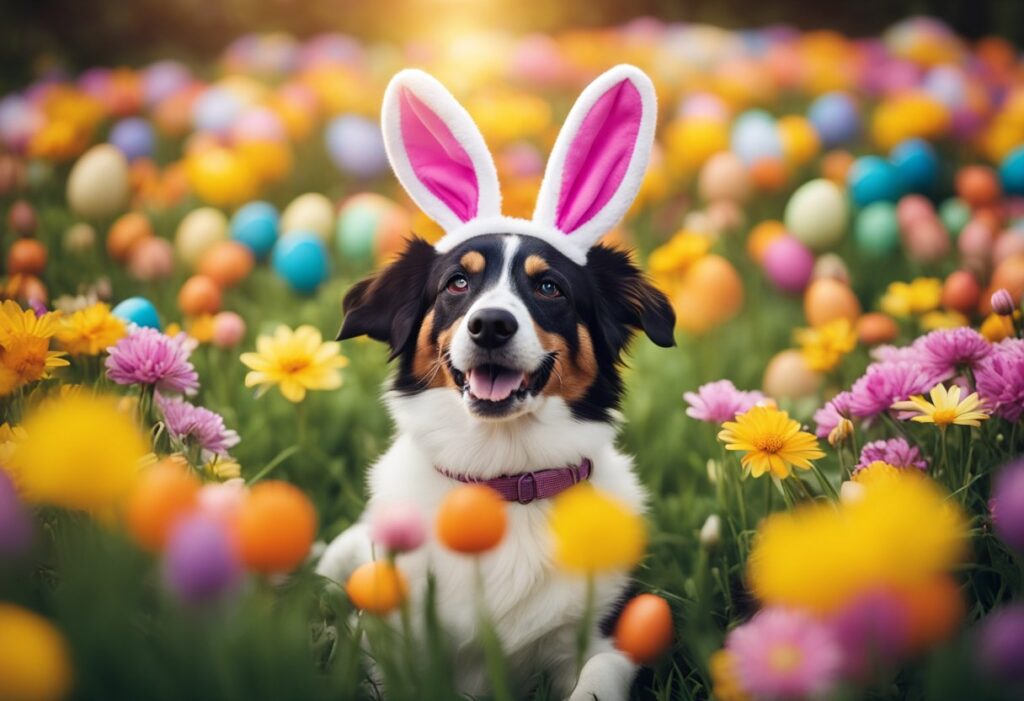
Hosting an Easter egg hunt for dogs is all about creating a joyful and secure environment. While it’s fun to see your furry guests eagerly searching for treats, safety must always take center stage. Every tail wag and happy bark should come with peace of mind. Here’s how to keep your event as safe as it is enjoyable.
Monitoring Canine Behavior
Dogs, like people, react differently in group settings. Some may be overly excited, while others might feel overwhelmed. Recognizing and managing these emotions ensures every pup stays happy and healthy throughout the event.
Look for signs of stress, such as:
- Ears pinned back or excessive yawning
- Avoiding interactions or retreating to a corner
- Growling, barking, or showing their teeth
Overexcitement, on the other hand, might look like persistent jumping, nonstop barking, or hyperactive dashing around the area. To manage this, consider setting up separate sections for quieter dogs and scheduling short breaks between activities to help them calm down.
Why not involve their owners? Assign handlers to supervise individual dogs and step in if needed—they know their pets’ needs best. Behavioral issues can often be avoided with close attention and a bit of patience. For further tips on handling canine behavior in diverse situations, visit Safety Tips for Traveling with Dogs in Your Car.
Avoiding Hazards
While you’re scattering treats around the yard or park, take a moment to survey the area for potential dangers. Dogs are naturally curious and might bite, step on, or swallow things they shouldn’t. Be proactive to avoid any unnecessary trips to the vet.
Here’s what to check for:
- Remove harmful plants: Some flowers, like daffodils and lilies, can be toxic to dogs if ingested.
- Clear away sharp objects: Broken twigs, glass, or sharp stones could harm paws or mouths.
- Eliminate choking hazards: Items small enough to fit in a dog’s mouth, such as bottle caps or coins, should be removed.
Using brightly colored and dog-safe toys or treat containers ensures nothing hazardous sneaks into your Easter display. Keep an eye on any decorative additions that might look tempting to your four-legged guests—like banners, balloons, or ribbons. Curious chews on the wrong item can derail the fun in no time.
Providing Water and Breaks
Just like us, dogs need to stay hydrated and relaxed during active events. With all the hunting and excitement, it’s essential to have designated spots for water breaks and some downtime.
Set up water stations with plenty of fresh drinking water at accessible points around the event area. Using a mix of bowls and pet water fountains can make it easy for all dogs to stay hydrated. Along with water, having a designated “chill-out zone” can work wonders. Fill the area with soft mats or shaded spots where dogs can take a moment to relax, especially on warm days.
Pay extra attention to signs of dehydration, such as:
- Panting heavily or excessively drooling
- Loss of focus or disinterest in activities
- Dry gums or lethargy
Keeping their energy balanced is key to a good time for everyone. For more ideas on keeping dogs cool and hydrated during outdoor activities, check out How to Keep Your Dog Cool This Summer.
By anticipating these needs, you’ll ensure the event remains a safe and enjoyable celebration for all participants, two-legged and four-legged alike.
Post-Hunt Fun and Care

The egg hunt may be over, but the fun and responsibility don’t end there! Whether you’re looking to extend the enjoyment with your furry guests or ensure everything is cleaned up properly, post-hunt activities add an extra layer of thoughtfulness to your event. Plus, sharing the memories with your dog community can inspire others to join in on the joy in the future.
Hosting a Doggy Playdate
Why let the excitement end with the last treat found? Turn your hunt into a full-fledged event by organizing a playdate for the participating pups. After all, dogs love social time just as much as humans do! A post-hunt play session can help pups burn off energy in a fun and supervised setting. Set up some additional toys, games, or even dog-friendly agility obstacles to keep the dogs engaged.
If you need more inspiration for dog playdate activities or fun, check out Fun Games Between Kids & Dogs. These ideas can also be adapted to include furry guests of all sizes and energy levels!
Remember to keep a close eye on interactions and ensure every pup feels welcome and comfortable. Offering breaks and access to fresh water is essential to keep tails wagging for the duration of their play session.
Cleaning Up After the Event
As a responsible pet parent and host, leaving the space as pristine as it was before the event started is important. Cleaning up after an Easter egg hunt for dogs isn’t just courteous—it’s also necessary to protect other pets, wildlife, and the environment.
Here’s a quick post-event checklist for easy cleanup:
- Retrieve all hidden items: Make sure no treat containers or toys are left behind.
- Dispose of broken or damaged pieces: Any plastic or fabric remnants should be carefully collected to prevent ingestion.
- Remove decorations safely: Balloons, streamers, or props can be hazardous if not properly thrown away.
- Check for left-behind waste: Even with responsible owners, it’s worth doing a final check to ensure the area is mess-free.
Keeping the area clean minimizes risks and sets a great example for other pet owners. For additional tips on maintaining safe and clean areas for your pets, visit 10 Reasons to Give Thanks for Your Dog, which discusses ways to care for pets and their environments.
Sharing Memories Online
The best part of any event is reminiscing—and what better way to do that than by sharing the joy online? Encourage your guests to post their photos and videos of the hunt on social platforms. This not only spreads festive cheer but also brings awareness to fun events like an Easter egg hunt for dogs!
Pro tips for sharing event memories:
- Use a unique hashtag (e.g., #EasterEggHuntPups).
- Share adorable highlights, like dogs proudly displaying their treat discoveries.
- Tag guests and their dogs so everyone feels included.
Embracing the storytelling aspect of your event not only builds community spirit but also encourages more dog parents to create similar experiences for their furry friends.
Conclusion
Hosting an Easter egg hunt for dogs is a fantastic way to bond, celebrate, and create joyful memories with your furry friend. By focusing on safety, planning, and incorporating fun elements like treat-filled challenges and Easter themes, you’re giving your pup an experience they’ll love.
Take time to prepare with simple training tips to ensure a stress-free event. You can explore activities like rally obedience for even more ideas on engaging your dog here.
Don’t forget to make this event inclusive. Download Easter dog coloring pages from Etsy to involve the whole family!
Whether you’re organizing a small backyard hunt or a larger gathering, the joy and connection this activity brings are unmatched. Make this Easter one your dog will wag their tail about for years to come.
Frequently Asked Questions
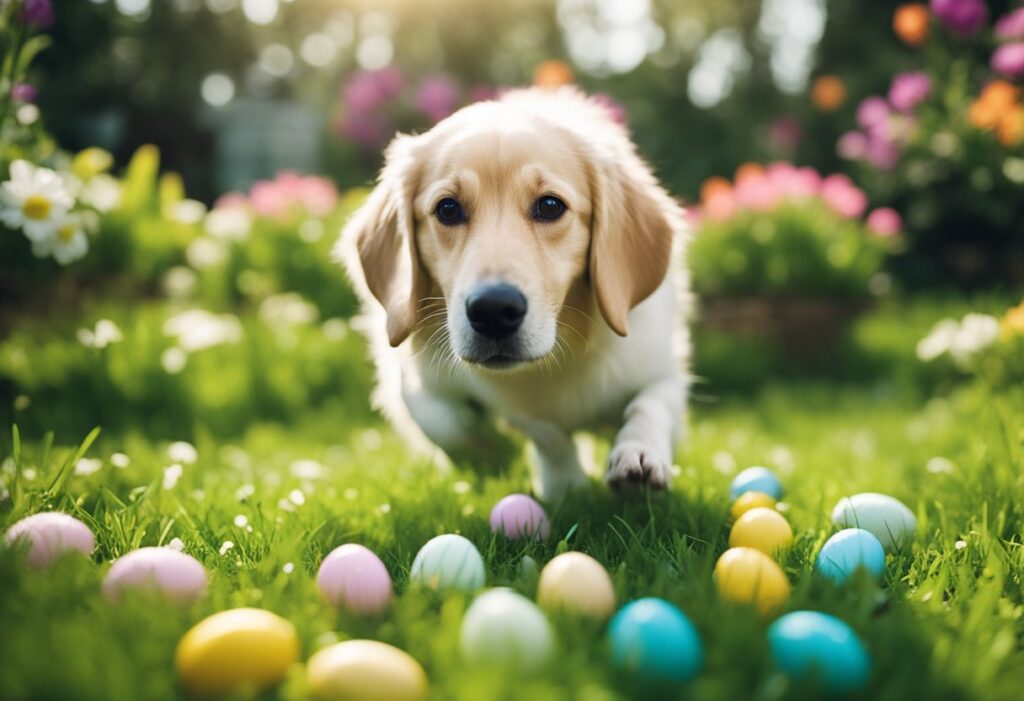
When planning an Easter egg hunt for your dog, it’s important to consider safety, suitable treats, and how to make the event enjoyable for them. Here are some common questions to help you create a memorable experience for your furry friend.
Can I give my dog chocolate Easter eggs?
Absolutely not. Chocolate is toxic to dogs, and even small amounts can lead to chocolate poisoning. Always keep chocolate Easter eggs out of your dog’s reach.
How can I safely involve my dog in a family Easter egg hunt?
To safely include your dog, keep them on a leash to prevent them from ingesting harmful objects or treats not meant for them, and use dog-friendly treats in the plastic eggs.
What are appropriate treats to hide in eggs for a dog Easter egg hunt?
Fill eggs with dog treats or kibble that are safe for your pet to eat. Ensure the treats are an appropriate size to prevent choking.
What kind of non-edible items can I use for a dog-friendly Easter egg hunt?
Consider hiding dog toys or chew items that encourage play and are safe for dogs. Make sure they are durable and the right size for your dog.
Are there any special considerations for keeping an Easter egg hunt safe for puppies?
For puppies, use larger eggs to reduce choking risks and avoid small, swallowable items. Monitor them closely during the hunt to ensure they’re not eating anything dangerous.
How do I create a fun Easter egg hunt for my dog indoors?
Set up an indoor hunt by hiding treats or toys behind furniture or under rugs. Create easy and fun hiding spots to keep your dog engaged and safe within the home.
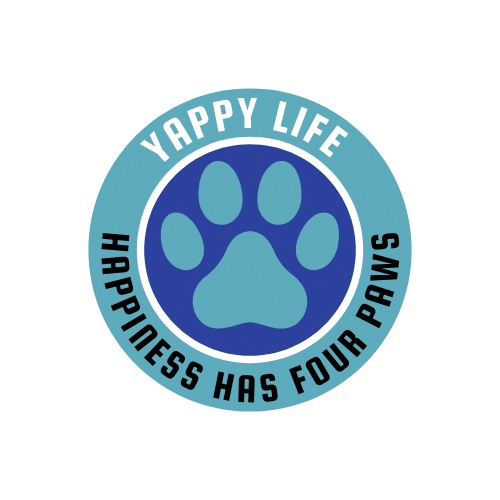
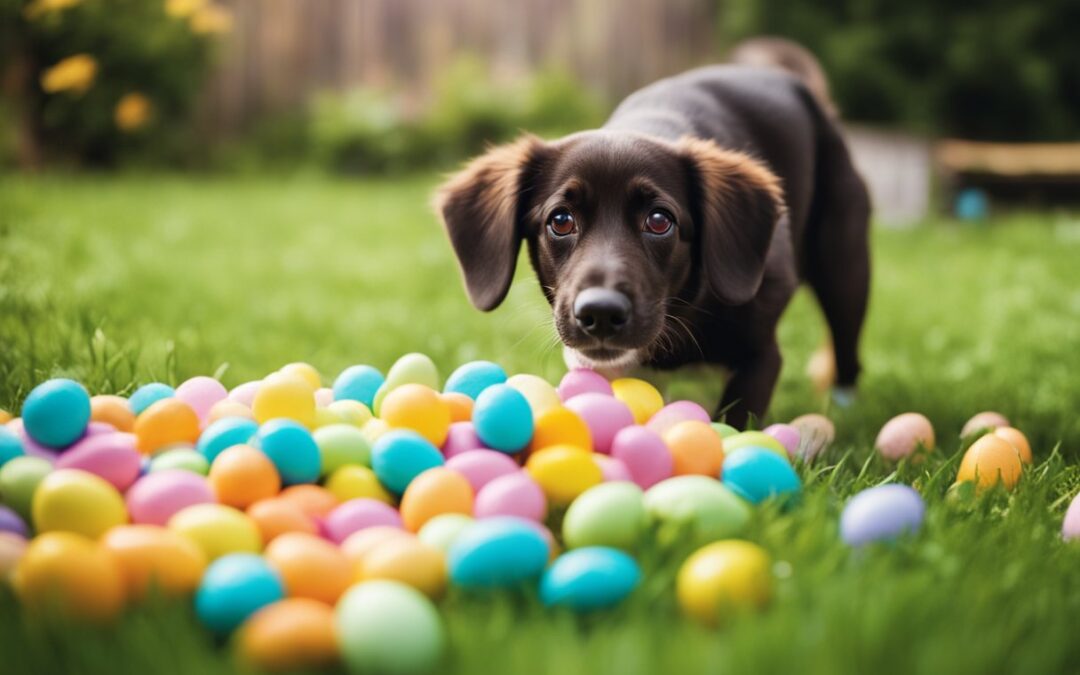
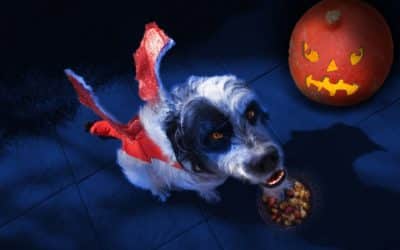
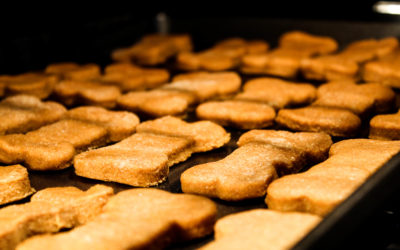
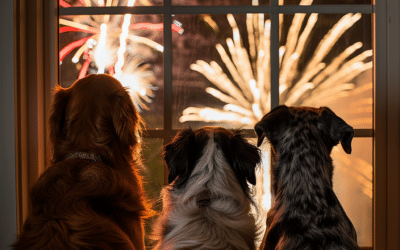
Recent Comments